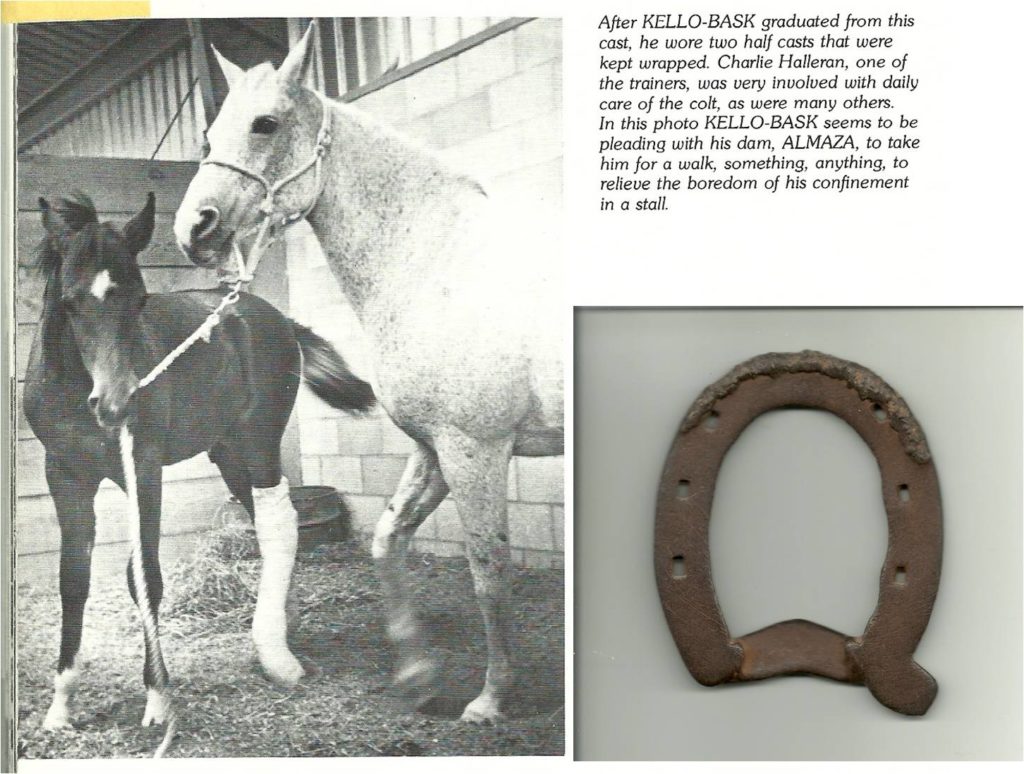Arabian Horse Historical Memories
By Doug Butler PhD, CJF, FWCF
Recently, as I was searching through my extensive collection of horseshoes I came across a shoe made for Kello-Bask, a yearling Arabian colt that I shod from 1967 to 1970. At the time of his first shoeing I had just been hired to teach farrier skills to students and shoe the Kellogg Arabian show horses at California State Polytechnic College in Pomona, California.
Kello-Bask, born in 1966, was one of the 1,046 progeny of *Bask, the imported Polish Arabian born in 1956, brought to America in 1963 by Dr. Eugene LaCroix to his Lasma Arabian Ranch in Scottsdale, Arizona.
Kello-Bask’s dam was Fadjineer who was by Fadjur who was out of Bint Sahara owned by Frank McCoy. 194 of *Bask’s foals became national winners. At Lasma’s first sale in 1971, 27 horses sold for an average of $19,000 each, with a *Bask daughter selling for $56,000. In 1973, another daughter sold for $117,000. His stud fee began at $500 and rose to $10,000 by 1975. Several *Bask sons were syndicated for $75,000 to $250,000 according to the editor of The Equiery.
*Bask died in 1979. “*Bask was widely recognized as the most influential sire of the Arabian breed in modern times,” according to Dr. LaCroix’s obituary, published by The Arizona Republic in 2004. It was also reported that *Bask and Man O’ War were the only two stallions buried at Kentucky Park in Lexington, Kentucky.
The tax advantage of owning Arabian horses, said by promoters to be “living art,” appealed to the rich and famous. Prices continued to inflate until the mid 1980’s. Some Arabians sold for millions of dollars. *Padron, an imported Russian Arabian, was syndicated for a record $11 million.
Many movie and recording stars regularly visited The Kellogg Arabian Ranch which was part of Cal Poly. However, when the tax advantages that allowed horse expenses to be deducted against real income were taken away by Congress in 1986, the expensive Arabian horse market crashed.
*Bask died of colic. He had 640 daughters, 50 were living in 1992 when I learned that 90% of the mares that had died, died of colic within the first 60 days of foaling. When pedigrees have *Bask on the top and the bottom, weanlings develop Cerebellar Abiotrophy causing loss of vitality and endurance, and rarely living more than 2 years. Some animals had it from birth.

Kello-Bask as a foal in a cast. The horseshoe, made by Doug Butler, helped to stabilize the leg as it healed and grew. Left picture from the book, The Kellog Arabian Ranch – The First Sixty Years by Mary Jane Parkinson, 1984, p. 404.
Kello-Bask had broken his leg as a foal, (apparently by falling off the mare while playing in the pasture). Charlie Halleran, school farrier and horse trainer, changed the casts to support the healing limb. The shoe I made prevented the yearling from running over the outside of his hoof. I reset this shoe many times as it helped the limb to grow straight. I put Borium on the toe to prevent excess wear. Eventually, I shod him with a keg shoe punched coarse on the outside. He later covered mares when he was mature. He was sold at age seven to an Arabian board member.
Related Posts
-
Recently I was discussing the state of the farrier business ...Jul 26, 2012 / 0 comments
-
©2013 Doug Butler PhD, CJF, FWCF Butler Professional Farri...Apr 10, 2013 / 0 comments
-
When a horse requires protection from excessive foot abrasio...Feb 14, 2019 / 0 comments
Blog Categories
- Anatomy
- Best Business Practices
- Conformation
- Current Events
- Customer Service
- Draft Horse Shoeing
- Equine Soundness
- Essential Anatomy Kit
- Farrier Careers
- Farrier training
- Foal soundness
- Horse Care
- Horse Foot Care
- Horse Owner Tips
- Horsemanship
- Horseshoeing
- Horseshoeing History
- Iron and Forge Work
- Student Spotlight
- Uncategorized
- Veterinary Care
Blog Archives
Contact Us
Butler Professional Horseshoeing School
495 Table Road
Crawford, NE 69339
(800) 728-3826
jacob@dougbutler.com
Subscribe to Our Blog
Get Our Free e-Book!
If you think you want to become a farrier (or know someone who does), this book can help you make that decision. Horse owners will learn the importance of choosing a qualified farrier and how to select the “right” one.
[ Get the e-Book Now! ]
- Follow:
